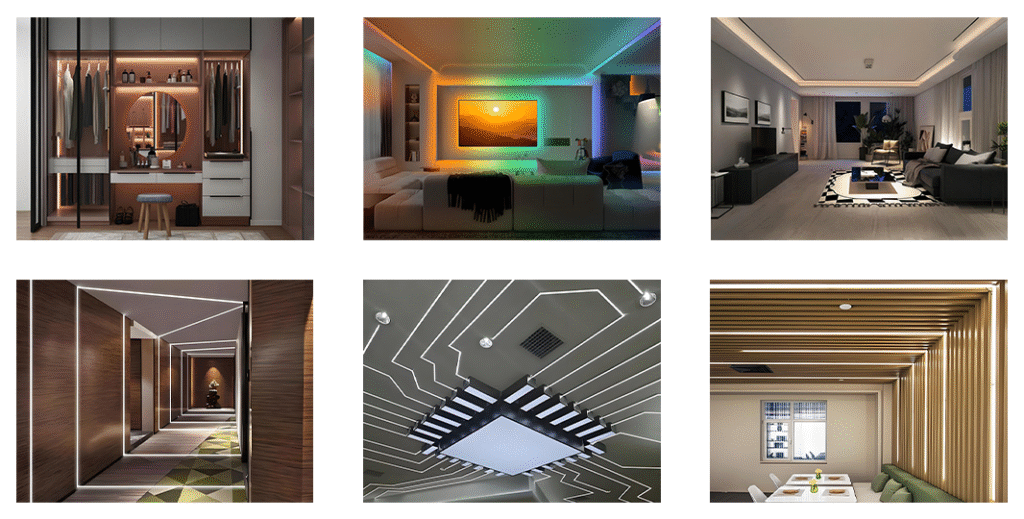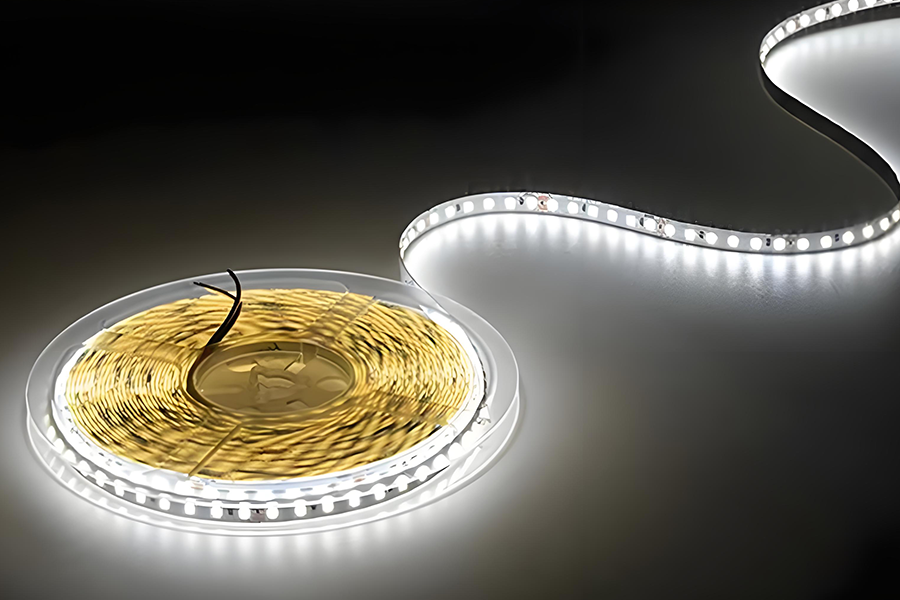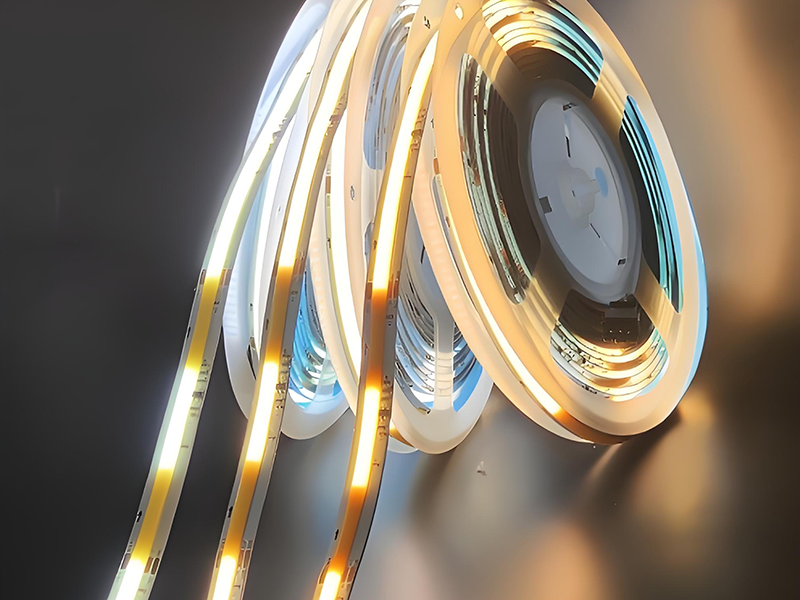In modern lighting and decorative design, LED strip lights have become one of the most common and flexible lighting products. Among all types of LED strips, LED SMD strips are the most widely used. So, what is LED SMD strip? What are its characteristics? What scenarios are applicable? This article will take you on a deep understanding of all aspects of LED SMD light strips, from structure, process, classification to application.
1.What is SMD LED lights?
LED SMD strip is a flexible circuit board strip that uses SMD (Surface Mounted Device) beads as the light source. It usually consists of the following parts:
1. FPCB (Flexible Circuit Board): It carries circuits and LED chips, and is flexible and bendable.
2. SMD LED beads: Surface mount LED chips, commonly available in specifications such as 2835, 5050, 3528, etc.
3. Resistive/IC components: used for current limiting or controlling light emission mode.
4. Solder joints and copper foil wiring: Ensure stable current transmission.
5. Adhesive backing (3M tape, etc.): Easy to install and stick on various surfaces.
Simply put, SMD LED strip is a lighting product that is formed by soldering tiny LED SMD beads onto a circuit board and adding necessary driving circuits to create a flexible and bendable strip that can continuously emit light.
2.How produce LED SMD light strip?
1. Material preparation
Raw material inspection: FPC flexible board (copper foil substrate), LED light beads, resistors, capacitors, IC (if IC light strip), protective components, etc.
Counting/Sorting: Confirm the material model and batch to ensure consistency and traceability.
2. Surface mount technology (SMT)
solder paste printing
Print solder paste through steel mesh at the solder pad position on the FPC board.
Check whether the thickness and position of the solder paste are uniform.
SMT assembly
The high-speed surface mount machine precisely attaches LED chips, resistors, and other components onto the FPC board.
reflow soldering
After passing through the reflow soldering furnace, the solder paste is melted and firmly bonded to the component pads.
Control the temperature curve to avoid virtual soldering and misalignment.
First Article Inspection
Check the direction and position of the light beads, and confirm that the circuit soldering is reliable.
3. Board division and testing
Visual inspection
Confirm Wuxi bead, connecting tin, virtual soldering, and missing parts.
Electrical performance testing
Power on and check if each LED is lit, and verify if the current and voltage are normal.
4. Glue filling/waterproofing (if required)
Waterproof level selection: IP20 (no waterproof), IP65 (drip glue), IP67 (sleeve sealing), IP68 (whole sealing).
Use silicone, PU or PVC sleeves according to requirements.
5. Cutting and welding
Cut according to customer length requirements.
Welding power cords or connectors.
Install terminals, connectors, or heat shrink tubing.
6. Aging and Quality Inspection
aging test
Turn on the power and run continuously for several hours to check for dead lights and color differences.
functional testing
Check brightness, color temperature, and color consistency.
For RGB, dimmable, and intelligent control light strips, control function testing is also required.
Finished Product Inspection
Appearance, size, light efficiency, and power testing.
7. Packaging
Roll up the reel (usually 5 meters per roll).
Anti static bags, color boxes, or vacuum formed packaging.
Pack the outer box, label it, and prepare for shipment.
3.Types and Differences of LED SMD Beads
Different SMD models determine the brightness, emission angle, and purpose of the light strip:
3528: Size 3.5 × 2.8mm, low single power, suitable for ambient lighting.
5050: Size 5.0 × 5.0mm, high brightness, can be equipped with RGB chips to achieve color change.
2835: Size 2.8 × 3.5mm, high brightness, good heat dissipation, high cost-effectiveness, widely used.
5630/5730: High power LED beads with high luminous efficiency, suitable for main lighting.
2216/3014: Small size, tightly arranged, suitable for high-density uniform luminous light strips.
For example, the 5050 RGB light strip can achieve full-color color change, while the 2835 monochrome light strip is mostly used for home and commercial lighting.
4.The main characteristics of LED SMD light strips
1. High brightness and uniformity
LED lights smd beads have high brightness and are densely arranged, providing stable and uniform lighting effects.
2. Flexible and bendable
FPCB substrates can be bent and cut to adapt to various complex installation environments.
3. Trimmable and extendable
Generally, there is a cutting point every 3 or 6 light beads, which can be cut according to the actual length requirements.
4. Multiple color temperatures and hues
Monochrome: Warm White, Natural White, Cool White.
RGB: Red green blue mixed color, adjustable for multiple colors.
RGBCCT: Adjustable color temperature and color.
5. Diversified protection levels
IP20: Bare board, unprotected, suitable for indoor dry environments.
IP65: Colloidal wrapping, splash proof.
IP67: Sealed with silicone tubing, suitable for outdoor use.
IP68: Fully sealed with adhesive, suitable for underwater environments.
6. Energy conservation and environmental protection
LED itself has low power consumption and long lifespan (usually 30000 to 50000 hours).
5.Classification of LED SMD strip lights
SMD led lights can be classified from different dimensions:
1. According to the bulb model: 2835 LED strip, 5050 LED strip, 3528 LED strip, etc.
2. Density arranged by lamp beads: 30 lamps/meter, 60 lamps/meter, 120 lamps/meter, 240 lamps/meter.
3. According to the supply voltage:
5V: commonly used for USB interface power supply, suitable for DIY.
12V: Commonly used for home and car lighting.
24V: Commercial lighting, low voltage drop, supports longer connections.
220V/110V high-voltage light strip: No power adapter required, directly driven by mains power.
By function: monochrome light strip, dual color adjustable light strip, RGB color changing light strip, address controllable (RGBIC) light strip.
According to the protection level: IP20~IP68.
6.Connection methods of LED SMD light strips

There are several ways to connect LED SMD strip lights: the most common is soldering, which firmly bonds the strip’s pads to wires, ensuring durability but requiring some skill; another is using solderless connectors, which simply clip onto the strip and wires for quick and tool-free installation; direct plug connectors are also available, ideal for linking two strips together or making corner connections; when installed in aluminum profiles, DC plugs or power adapters can be used for direct connection to power sources, making them convenient for home and commercial use; in larger projects, parallel wiring is often applied, where multiple lines run from the power supply to different sections of the strip to maintain even brightness. In short, LED SMD strips can be connected through soldering, solderless connectors, plug connectors, DC plugs, or parallel wiring, and the best method depends on the application—balancing efficiency, stability, and safety.There are several ways to connect LED SMD strip lights: the most common is soldering, which firmly bonds the strip’s pads to wires, ensuring durability but requiring some skill; another is using solderless connectors, which simply clip onto the strip and wires for quick and tool-free installation; direct plug connectors are also available, ideal for linking two strips together or making corner connections; when installed in aluminum profiles, DC plugs or power adapters can be used for direct connection to power sources, making them convenient for home and commercial use; in larger projects, parallel wiring is often applied, where multiple lines run from the power supply to different sections of the strip to maintain even brightness. In short, LED SMD strips can be connected through soldering, solderless connectors, plug connectors, DC plugs, or parallel wiring, and the best method depends on the application—balancing efficiency, stability, and safety.
7.Application scenarios

LED SMD light strips are widely used in:
Home lighting: ceiling, cabinet, stairs, TV background wall.
Commercial spaces: shopping malls, shop windows, hotels, restaurants, ambient lighting.
Cars and yachts: interior ambient lights, underbody lights, ship lights.
Stage and entertainment venues: RGB dynamic effect light strips create an atmosphere.
Outdoor lighting: building outlines, advertising light boxes, landscape decoration.
8.Key points for installation and use
Power matching: Select the appropriate power adapter based on the voltage of the light strip. Reserve 20% power margin to avoid overload.
Heat dissipation and lifespan: When lit for a long time, it is recommended to pair it with an aluminum shaped lamp slot to improve heat dissipation and extend lifespan.
Connection method: Welding or solder free terminals can be used.
When installing over long distances, power should be supplied from both ends to avoid voltage drops.
Control method:
Monochrome: Dimmer.
RGB/RGBW: Controller+Remote Control/WiFi/Bluetooth/MX.
Intelligent control: mobile app, smart speaker linkage.
9.Conclusion
LED SMD strip is a flexible, energy-saving, and easy to install lighting product that combines decoration and practicality. It can meet various needs from home lighting to commercial engineering through different SMD bulb models, power supply methods, protection levels, and control systems.
Whether creating a warm home atmosphere or achieving dazzling commercial lighting effects, LED SMD light strips are an indispensable and important choice in modern lighting design.



